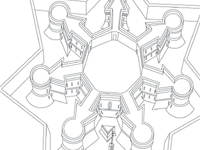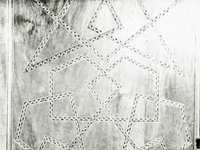"Tutte le fortezze che nella mente occorrano continuamente, sarebbe un processo in infinito." (All of the fortresses that continually occur to the mind would proceed into infinity.)—Francesco di Giorgio Martini, Trattati
 Fig. 7.1. Heptagonal fortress. Fig. 7.1. Heptagonal fortress. |
 Fig. 7.2. Heptagonal figure from area of Urbino studiolo. Fig. 7.2. Heptagonal figure from area of Urbino studiolo. |
1The history of the art of memory has been characterized as an evolving experiment in forming associations between the visible and invisible.1 It is difficult to predict and control the products of this experiment. As Horace observes, some results are comical and absurd, while others provoke an observer to puzzle over their possible significance, allowing "more for the mind to discover," Alberti suggests, "than is actually apparent to the eye."2 Complementary to memory, architecture is an ongoing experiment that makes visible our evanescence, as quarry for further dreaming and reflection. Although the exact appearance and contents of mnemonic palaces and cities vanish irretrievably with their authors, we may discern the following from the evidence available: at the moment of their physical completion, in the presence of their patron, architect, scholarly consultants, and artisans, the Gubbio and Urbino studioli embodied a deep history of ideas and practices of knowing, gathered and presented in a highly innovative manner. It is precisely by their capacity to engage the observer to speculate on the meanings of particular images—as well as the potential meanings constellated from clusters of images—that these chambers reveal their quintessence. The studioli offer mnemonic engines within which each visitor figures as a participant-agent, retrieving associations and forging them anew.